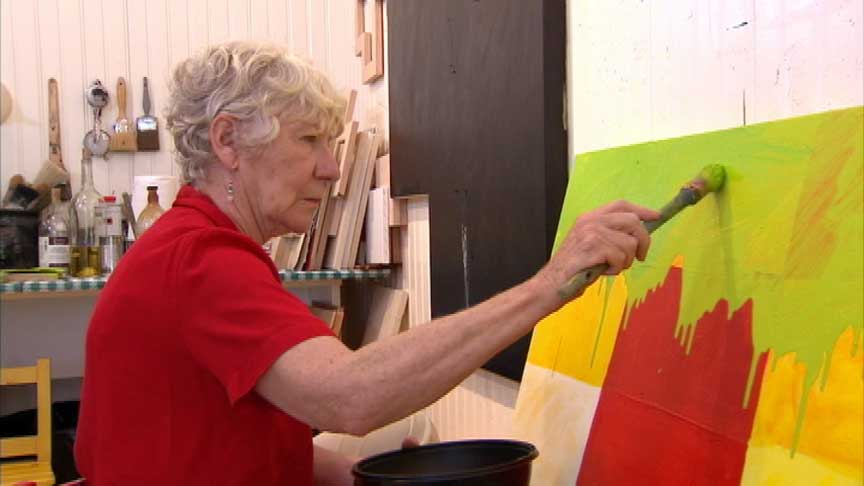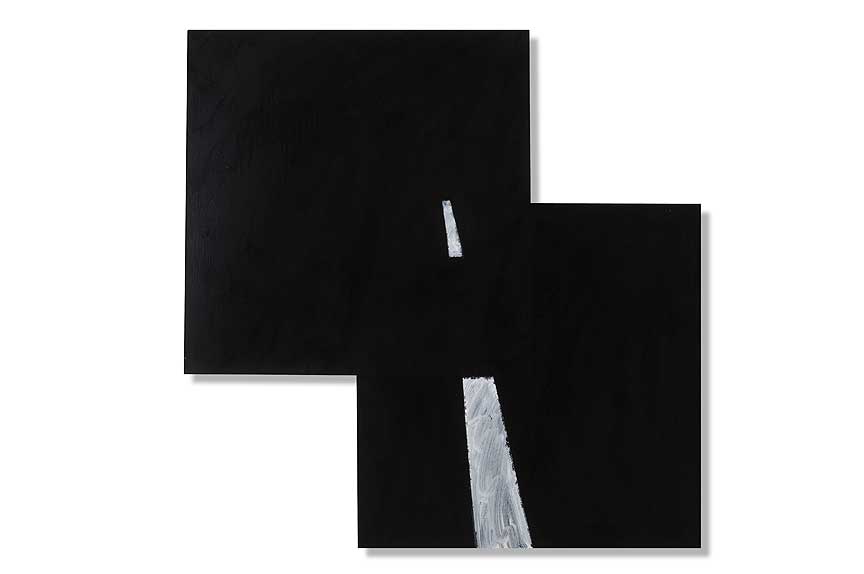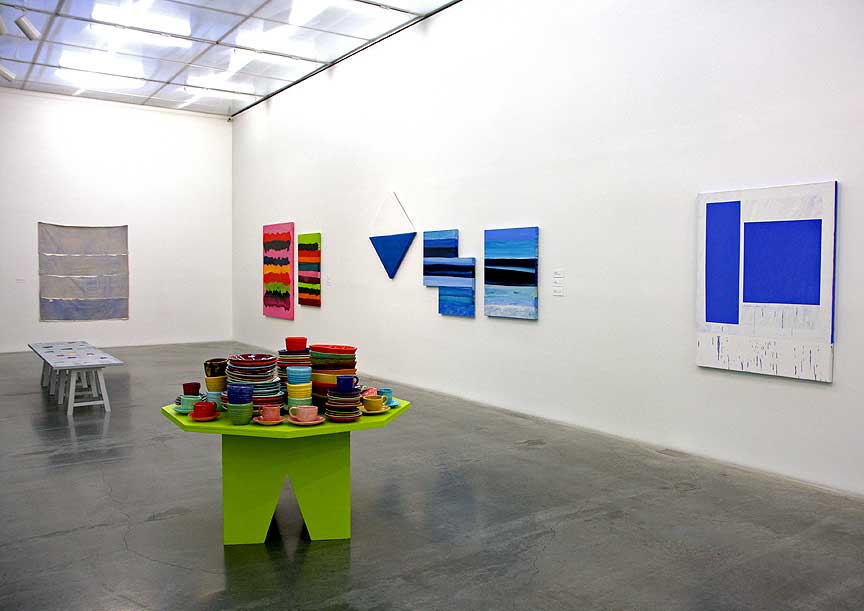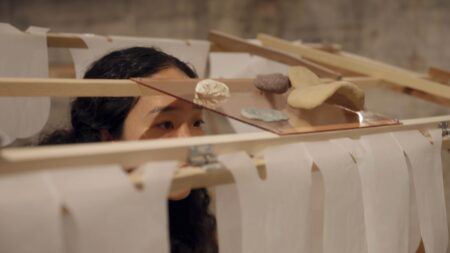Interview
Every Piece has a Backstory

Production still from the Art in the Twenty-First Century Season 5 episode, Fantasy. © Art21, Inc. 2009.
This interview consists of excerpts from a 2008 interview with Mary Heilmann, in which she discusses her formative years in California; evolution from literature to ceramics to painting; and many inspirations, including video games and roadways.
ART21: When do you start a body of work?
HEILMANN: A body of work starts by daydreaming, imagining, looking at my own work, the work that’s already around in the studio, and looking at the work on the computer. All the images that I’ve done are on the computer now. And the work is always made by morphing previous work. Speaking of getting ideas, I can’t think of specific impulses and ideas that I’ve gotten from my students or practicing artists but, I have really been, as I say, inspired by other people. Now since we’re in the era of post-modernism, I can actually say I really do take ideas. If I see a good idea, forget about it! It’s mine! And I often put the person’s name in the piece. It is kind of a philosophical idea, a truth, that any object of art is really made out of all the other objects of art that come before it and at the same time.
I had my Neo-Geo phase. My boss at the School of Visual Arts thought of that title for the work that was done in the mid ’80s by Peter Halley. I was doing some geometrical work in the mid ‘80s, when I was trying to sort of re-launch my art career. I had been hiding out. So, I started having people come over to see my work, and everyone picked up on Neo-Geo! That’s when I started getting some attention again.
ART21: What pushes you into a new phase of work?
HEILMANN: My inspiration often comes from popular culture. And I guess it also comes out of my daydreaming…I’m now in my psychedelic phase and I’m doing the vanishing point thing at the same time. How did that happen? I’m looking at all these movies that have roads in them and I just get stuck on an idea like that. And video games, I love looking at video games, not to play them, but just to think about how amazing it is that they can figure out how to make these things. And then I also love zooming down roads I don’t really know. I guess a lot of inspiration does come from movies.

Mary Heilmann. Two Lane Blacktop, 2008. Oil on canvas; 42 × 42 inches. © Mary Heilmann. Courtesy of the artist, 303 Gallery, New York and Hauser & Wirth, Zürich London.
ART21: Are you referring back to other artists?
HEILMANN: I think about Ellsworth Kelly. The shaped canvas comes out of my own thinking about geometry. A lot of my time figuring out what to make is spent by doing some basic counting and measuring, and trying to figure out how big different elements of a piece should be. I could spend days obsessively thinking about two inches, three inches, six inches. It’s very much a mental exercise.
I’ve been sitting on the bus, going down the expressway, making video of two-lane roads. Simple ideas become obsessions, almost like a meditation.
The vanishing point painting that I made called Two-Lane Blacktop—I love it. It’s one black thing with two little lines on it. I’d probably been thinking about it for four months, trying to figure out how to get that just right—and then I got it. And once I think I’ve got it, I’ll make about twelve of those paintings.
ART21: Do you experiment?
HEILMANN: A little bit. But then I try it out on different, actual physical scale. I think about it forever and then I make it physically. The reason I don’t just fool around making it physically goes back to thinking about how the Abstract Expressionists worked, just duking it out, poking the painting, rubbing it off, and putting it back on. I am just too lazy to do that, so I like to just think about it forever and then finally try it out. And a lot of times it comes out right. Now that I have my computer, I do a little basic fooling around in graphic programs, not so much with scale, but with colors. Seeing the colors on the screen of the laptop has really influenced my color in the last ten or fifteen years.
ART21: Can you explain that a little?
HEILMANN: Well, I got really in love with this chartreuse-ish kind of green, which we used to see all the time on the computer, and with computer graphics, too. And I got inspired by the color of light that I constantly saw as I played with my computer. It probably seeped into my consciousness about making the paintings. I’m wondering when I’m ever going to get tired of this green.

Production still from the Art in the Twenty-First Century Season 5 episode, Fantasy. © Art21, Inc. 2009.
ART21: Does it have to do with living in the country?
HEILMANN: When I moved out here to the east end of Long Island, in the midst of all this green, my color perked up. It made my green much more varied. It’s not all chartreuse anymore, but it isn’t out of nature; it’s really out of artifice.
ART21: Talk about painting as lifelong practice.
HEILMANN: I wasn’t one of those children who were gifted at doing artwork. I just made a big mess and I liked that. I remember the teacher trying to make me stay in the lines when I was coloring and I didn’t. And it wasn’t that I was handicapped or challenged, I just didn’t want to stay inside of the lines. I wonder what that was about? It’s similar to how I am now. As a child I wasn’t gifted at drawing and painting, but I was good at making sculptural, three-dimensional things. And I was pretty good at writing right from the beginning. I remember getting a lot of praise for writing where I really got in trouble for my artwork. I think stories are really important.
Every piece of abstract art that I make has a backstory. When minimalism ended, post-modernism started for me, and I started giving the pieces fanciful titles that related to some kind of narrative that was going on with me. So the titles are often like a three-word poem that is a part of the piece. It’s really opened up my work to where I can make an abstract expressionist gestural painting next to a geometrical painting next to an image of a piano, and it kind of makes sense for me.

Flying Saucer Project ceramics on Chartreuse Table, 2008. Installation view of Mary Heilmann: To Be Someone at the New Museum, New York, October 22, 2008–January 25, 2009, © Mary Heilmann. Courtesy of the artist, 303 Gallery, New York and Hauser & Wirth, Zürich London.
ART21: Do you keep a diary?
HEILMANN: I do keep a diary and I basically just make notes about whatever happened the day before. I write in it in the morning. I’ve had it now for about twenty years, so I can look back and see what was going on and I like to do that—and I like to read it and remember how I felt way back.
As an undergraduate, I had planned to study writing. I got sidetracked because my mom was really concerned that I be able to make a living (and I thank her for that), so I went to school to get accredited to be a school teacher. While I was at San Francisco State University studying education, I started doing ceramics. I had a talent for it and throwing pots on the wheel was kind of hard to do. It really was a lot easier for me than writing and reading texts and then writing about literature.
Later on, in the early ’90s, there was a big recession and the art magazines would have artists write pieces and we didn’t get paid. I started writing about my work and when people would see an image and then read the writing they started to like my work. They got into the works through the writing…The writing practice and the art practice really going hand-in-hand now.

Flying Saucer Project ceramics on Chartreuse Table, 2008. Installation view of Mary Heilmann: To Be Someone at the New Museum, New York, October 22, 2008–January 25, 2009. © Mary Heilmann. Courtesy of the artist, 303 Gallery, New York and Hauser & Wirth, Zürich London.
ART21: What drew you to ceramics?
HEILMANN: I had some friends at Santa Barbara State University who were doing ceramics, especially a boyfriend. In the early ‘60s, there was a whole scene in Santa Barbara, like a late beatnik, early hippie type of scene where people were throwing pots, not at school, but in the town. My friend showed me how to put a lump of clay on the wheel and throw a pot and I took to it right away. Everybody would say, “Whoa.” I got a lot of props for being good at throwing pots. I loved it. I loved the atmosphere of it, the milieu. Then I found out about Peter Voulkos, who was teaching up at University of California, Berkeley. (I was in southern California in the early ‘60s and big stuff was happening in ceramics with Voulkos, John Mason, and Ken Price, who was in school at the time.) First, I went to San Francisco State University and to study the education thing so I could get a job, and then, I went over to Berkeley for graduate school.
At Berkeley, we were doing ceramic sculpture inspired by Voulkos, sort of abstract expressionist ceramic sculptures on a huge scale, with a tremendous amount of craft involved in making, firing, and glazing them. It was quite an intense scene, working all night. When I wanted to make things really stand up (it was kind of hard to), we switched to welding steel, looking at the New York School sculptors, the early guys, especially David Smith who was a big inspiration. Then I get to know Bruce Nauman who was in school at the same time but up at the University of California, Davis. The rest is history. I found out about the rest of what was going on—what became minimal and then post-minimal.



